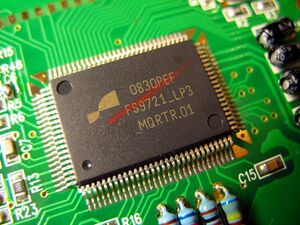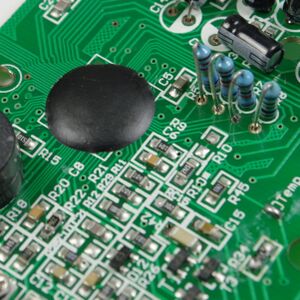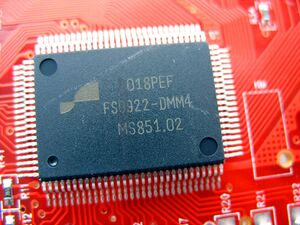Difference between revisions of "Multimeter ICs"
Uwe Hermann (talk | contribs) m |
Uwe Hermann (talk | contribs) |
||
| Line 83: | Line 83: | ||
[[File:Voltcraft vc820 fs9721 lp3.jpg|thumb|right|FS9721_LP3 on [[Voltcraft VC-820]].]] | [[File:Voltcraft vc820 fs9721 lp3.jpg|thumb|right|FS9721_LP3 on [[Voltcraft VC-820]].]] | ||
[[File:Tp4000zc_chip.jpg|thumb|right| | [[File:Tp4000zc_chip.jpg|thumb|right|FS9721_LP3 (?) on [[TekPower TP4000ZC]].]] | ||
== Protocol == | == Protocol == | ||
Revision as of 01:04, 11 November 2012
This page lists some information about ICs commonly used in various multimeters (DMMs).
Overview
Many multimeters use a special-purpose multimeter IC internally. This table lists those chips, as they're often directly responsible for the protocol and data format of the PC logging functionality of a multimeter.
| Vendor | Device | Builtin PC interface | Comments |
|---|---|---|---|
| Cyrustek | ES51922 | RS232, TX only, 19230 baud, 7o1 | Data is sent via the SDO pin. Data logging can be en/disabled via RS232 pin. |
| Fortune Semiconductor | FS9721_LP3 | RS232, TX only, 2400 baud, 8n1 | Data is sent via the TXD pin. Data logging can be en/disabled via ENTX pin. |
| Fortune Semiconductor | FS9922_DMM4 | RS232, TX only, 2400 baud, 8n1 (?) | Data is sent via the TXD pin. Data logging can be en/disabled via TXEN pin (?) and the REL/RS232 pin (?). |
| Intersil | ICL7106 | ? | |
| Intersil | ICL7136 | ? | |
| Intersil | ICL7139/ICL7149 | none (?) | |
| MASTECH | M343-01 | ? | |
| Maxim | MAX130/131 | ? | |
| Maxim | MAX133/134 | ? | |
| Metex | KS57C2016 | ? | Possibly a relabel'd Samsung KS57C2016 4-bit microcontroller. |
| New Japan Radio | NJU9207 | none |
Fortune Semiconductor FS9721_LP3


Protocol
The chip periodically sends 14-byte packets at 2400 baud, 8n1. The upper nibble of each byte indicates the byte number. The payload is composed of the lower nibbles, and is a 1-1 mapping of the LCD segments. The downside to this protocol structure is that transmission errors in the LSB nibbles cannot be detected. There is no checksum or CRC in the packet.
Packet structure:
| Byte | Bits 7-4 | Bit 3 | Bit 2 | Bit 1 | Bit 0 |
|---|---|---|---|---|---|
| 0 | 0x1 | AC | DC | Auto | RS232 |
| 1 | 0x2 | Negative | 1A | 1B | 1C |
| 2 | 0x3 | 1D | 1E | 1F | 1G |
| 3 | 0x4 | DP1 | 2A | 2B | 2C |
| 4 | 0x5 | 2D | 2E | 2F | 2G |
| 5 | 0x6 | DP2 | 3A | 3B | 3C |
| 6 | 0x7 | 3D | 3E | 3F | 3G |
| 7 | 0x8 | DP3 | 4A | 4B | 4C |
| 8 | 0x9 | 4D | 4E | 4F | 4G |
| 9 | 0xa | u | n | k | Diode |
| 10 | 0xb | m | % | M | Beep |
| 11 | 0xc | Farads | Ohms | Rel | Hold |
| 12 | 0xd | A | V | Hz | Low battery |
| 13 | 0xe | User bit 3 | User bit 2 | User bit 1 | User bit 0 |
Segment lettering:
| C | ||
| B | G | |
| F | ||
| A | E | |
| D |
Fortune Semiconductor FS9721B
TODO.
Fortune Semiconductor FS9922-DMM3
TODO.
Fortune Semiconductor FS9922-DMM4

The Fortune Semiconductor FS9922-DMM4 (datasheet) is a widely used 6000-count auto-ranging DMM chip: it takes input from the various controls on the front panel, drives the LCD display, and can communicate its readings via a serial port.
Protocol
TODO